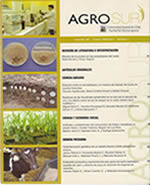Effect of reforestation on soil properties in Cauquenes tailings dam, El Teniente mine, Libertador Bernardo O´higgins Region, Chile
Main Article Content
Abstract
Phytostabilisation involves the simultaneous use of exclusive metalophilic plants and substrate conditioners to achieve the physical, chemical, and biological stabilisation of degraded soil. This work is based on a comparative study of four phytostabilisation campaigns with Acacias, Cupressus, Eucalyptus, Quillaja, and Cryptocaria among others, and one target area, both located in the Cauquenes tailings dam, 12 km far from the city of Rancagua. The study evaluated the effectiveness of phytostabilisation as a remediation technique through the monitoring of substrate physico-chemical variables using comparative analysis of their space-time distributions, considering an initial incorporation of lime. The studied properties were the organic matter content (OM), nitrogen (N), phosphorus (P), potassium (K), pH, electrical conductivity (EC), humidity, texture and heavy metals concentration (Cr, Ni, Cu, Zn, As, Pb, Cd). Non-metric multidimensional scaling (NMDS) and statistical analysis showed that edaphic properties improved over time. This improvement was observed as an increase in the clay percentage, the contents of OM and N, K, P and a decrease in acidity after years of phytostabilisation. The concentration of heavy metals showed a time decrease for Cu, Cr, Ni, Pb, and As attributed to phytoextraction processes. Results showed that phytostabilization is an effective technique that leads to the physical and chemical stabilisation of the Cauquenes tailings dam, which is observed through the improvement of edaphic properties and decrease of the risk of pollutant dispersion, and it can be applied in other places.

